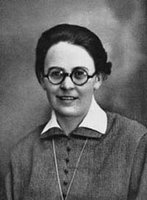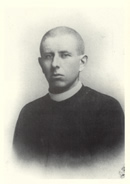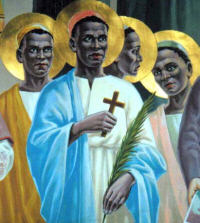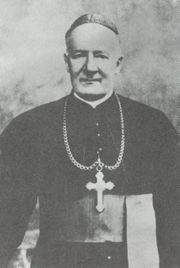Today Pope Benedict XVI will canonize four holy people and formally declare them to be saints in Heaven. Canonizations are always a joyous day for the Church! Those who shall be canonized include Fr. George Preca, Fr. Simon of Lipnica, Fr. Charles of St. Andrew, and Marie Eugenie of Jesus Milleret.
 Fr. Charles of St. Andrew (1821 - 1893) was a Passionist from Ireland. Born in Holland, he spent most of his life ministering in the south Dublin suburb of Mount Argus. Consequently, he is frequently called Charles of Mount Argus. Born in 1821 in Holland, John Andrew Houben joined the Passionist order at the young age of 19. Fr. Charles of St. Andrew arrived in Mount Argus as it was being founded and he around Ireland raising funds to help build it. Fr. Charles ministered especially to the sick and dying. Because he did not master English well, he was not a formal preacher, but he reached the Faithful through the Sacrament of Confession, which he championed. As word of his healing powers spread, people from all of Ireland came to him. When his funeral occurred in 1893, thousands of people journeyed to Mount Argus, where the body of Fr. Charles lay in state for five days. His remains were moved to a shrine in the Church in 1949. He was beatified by Pope John Paul II in 1988. Additional information on his life and his canonization miracle are available on the Vatican's website.
Fr. Charles of St. Andrew (1821 - 1893) was a Passionist from Ireland. Born in Holland, he spent most of his life ministering in the south Dublin suburb of Mount Argus. Consequently, he is frequently called Charles of Mount Argus. Born in 1821 in Holland, John Andrew Houben joined the Passionist order at the young age of 19. Fr. Charles of St. Andrew arrived in Mount Argus as it was being founded and he around Ireland raising funds to help build it. Fr. Charles ministered especially to the sick and dying. Because he did not master English well, he was not a formal preacher, but he reached the Faithful through the Sacrament of Confession, which he championed. As word of his healing powers spread, people from all of Ireland came to him. When his funeral occurred in 1893, thousands of people journeyed to Mount Argus, where the body of Fr. Charles lay in state for five days. His remains were moved to a shrine in the Church in 1949. He was beatified by Pope John Paul II in 1988. Additional information on his life and his canonization miracle are available on the Vatican's website.
 Fr. George Preca (1880 - 1962) was a diocesan priest and the Founder of the Society of Christian Doctrine, M.U.S.E.U.M. Born in Valletta, Malta, on Feb. 12, 1880, he was baptized on Feb. 17, 1880. When he was 17 years old, one of his Lyceum professors, Father Ercole Mompalao, told him: "Preca, when you grow up, people who revere God will befriend you and you them. You will find your good fortune through them and they through you." Afterwards, George Preca entered a seminary in Malta. George Preca said that after his spiritual director, Father Aloysius Galea, died on April 8, 1905, he appeared to him a few days afterwards saying, "God has chosen you to teach his people." A few days before his ordination, George Preca nearly died but was saved through the intercession of St. Joseph. Ordained a priest on December 22, 1906 by Bishop Pietro Pace, and he celebrated his first Solemn Mass at the St Cajetan Parish Church in Ħamrun on Christmas Day. Fr. George Preca soon founded the Society of Christian Doctrine, which consisted of a group of lay people leading an exemplary life, well formed in the principles of the Catholic faith and sent to teach the faith to the people. It became called M.U.S.E.U.M., Magister Utinam Sequatur Evangelium Universus Mundus. On July 26, 1962, George Preca left this earth and returned to God. More information on his life and the order he founded are available on the Vatican's website.
Fr. George Preca (1880 - 1962) was a diocesan priest and the Founder of the Society of Christian Doctrine, M.U.S.E.U.M. Born in Valletta, Malta, on Feb. 12, 1880, he was baptized on Feb. 17, 1880. When he was 17 years old, one of his Lyceum professors, Father Ercole Mompalao, told him: "Preca, when you grow up, people who revere God will befriend you and you them. You will find your good fortune through them and they through you." Afterwards, George Preca entered a seminary in Malta. George Preca said that after his spiritual director, Father Aloysius Galea, died on April 8, 1905, he appeared to him a few days afterwards saying, "God has chosen you to teach his people." A few days before his ordination, George Preca nearly died but was saved through the intercession of St. Joseph. Ordained a priest on December 22, 1906 by Bishop Pietro Pace, and he celebrated his first Solemn Mass at the St Cajetan Parish Church in Ħamrun on Christmas Day. Fr. George Preca soon founded the Society of Christian Doctrine, which consisted of a group of lay people leading an exemplary life, well formed in the principles of the Catholic faith and sent to teach the faith to the people. It became called M.U.S.E.U.M., Magister Utinam Sequatur Evangelium Universus Mundus. On July 26, 1962, George Preca left this earth and returned to God. More information on his life and the order he founded are available on the Vatican's website.
 Fr. Simon of Lipnica (c. 1435 - c. 1482) was a 15th-century Polish Franciscan, who died during the Plague. Born in Lipnica Murowana, in the south of Poland, between the years 1435-1440, Simon of Lipnica was early inspired by the preaching of the Franciscan St. John of Capistrano. Around the year 1460, Simon of Lipnica was ordained a priest of Our Lord Jesus Christ. Like both St. Bernardino of Siena and St. John of Capistrano, spread devotion to the name of Jesus. In 1463, he became the preacher at the Cathedral of Wawel in Krakow. When the Plague broke out in Krakow from from July 1482 to 1483, Fr. Simon comforted and aided the sick and even administered the sacraments to the sick and dying, until Fr. Simon was infected. In an act of great humility, Fr. Simon asked to be buried under the threshold of the church so that all could trample on him. On July 18, 1482, the sixth day of his suffering, Fr. Simon of Lipnica died. Fr. Simon was beatified by Pope Innocent XI on Feb. 24, 1685. Again, additional information is available on the Vatican's website.
Fr. Simon of Lipnica (c. 1435 - c. 1482) was a 15th-century Polish Franciscan, who died during the Plague. Born in Lipnica Murowana, in the south of Poland, between the years 1435-1440, Simon of Lipnica was early inspired by the preaching of the Franciscan St. John of Capistrano. Around the year 1460, Simon of Lipnica was ordained a priest of Our Lord Jesus Christ. Like both St. Bernardino of Siena and St. John of Capistrano, spread devotion to the name of Jesus. In 1463, he became the preacher at the Cathedral of Wawel in Krakow. When the Plague broke out in Krakow from from July 1482 to 1483, Fr. Simon comforted and aided the sick and even administered the sacraments to the sick and dying, until Fr. Simon was infected. In an act of great humility, Fr. Simon asked to be buried under the threshold of the church so that all could trample on him. On July 18, 1482, the sixth day of his suffering, Fr. Simon of Lipnica died. Fr. Simon was beatified by Pope Innocent XI on Feb. 24, 1685. Again, additional information is available on the Vatican's website.
 Marie Eugenie of Jesus Milleret also called Anne Marie Eugenie (1817 - 1898) was born to a non-believing, rich family in France after the defeat of Napoleon. Her liberal father was even a follower of Voltaire. Voltaire hated the Church and, according to one famous story, died without the Sacrament of Last Rites because his friends beat the priest in order to stop him from entering the house of the dying Voltaire. Anne Marie Eugenie went to Mass on feastdays but did not truly follow the Church until the mystical experience of her First Communion. By the age of 15, her parents had separated and her father's banks had failed. Anne Marie Eugenie journeyed with her mother to France, but her mother soon died on cholera only a few hours after receiving the illness. Anne Marie Eugenie was alone. At this time, Anne met Father Combalot, who recognized that he had found the person who was designated to be the foundress of the congregation he had dreamed of for a long time. Fr. Combalot soon convinced her that only by education could she evangelize minds, make families truly Christian, and thus transform the society of her time. At the age of 22, Marie Eugenie founded Religious of the Assumption, a group of nuns dedicated to consecrate their whole life to extending the Kingdom of Christ in themselves and in the world. She once said, "All is from Jesus Christ, all belongs to Jesus Christ, all must be for Jesus Christ." On March 10, 1898, Anne Marie Eugenie died peacefully. More information is available on the Vatican's website. Her organization still remains but, unfortunately, after examining the website of the Religious of the Assumption, it seems that the organization is sliding towards modernism by not requiring nuns to wear the habit. How disappointing.
Marie Eugenie of Jesus Milleret also called Anne Marie Eugenie (1817 - 1898) was born to a non-believing, rich family in France after the defeat of Napoleon. Her liberal father was even a follower of Voltaire. Voltaire hated the Church and, according to one famous story, died without the Sacrament of Last Rites because his friends beat the priest in order to stop him from entering the house of the dying Voltaire. Anne Marie Eugenie went to Mass on feastdays but did not truly follow the Church until the mystical experience of her First Communion. By the age of 15, her parents had separated and her father's banks had failed. Anne Marie Eugenie journeyed with her mother to France, but her mother soon died on cholera only a few hours after receiving the illness. Anne Marie Eugenie was alone. At this time, Anne met Father Combalot, who recognized that he had found the person who was designated to be the foundress of the congregation he had dreamed of for a long time. Fr. Combalot soon convinced her that only by education could she evangelize minds, make families truly Christian, and thus transform the society of her time. At the age of 22, Marie Eugenie founded Religious of the Assumption, a group of nuns dedicated to consecrate their whole life to extending the Kingdom of Christ in themselves and in the world. She once said, "All is from Jesus Christ, all belongs to Jesus Christ, all must be for Jesus Christ." On March 10, 1898, Anne Marie Eugenie died peacefully. More information is available on the Vatican's website. Her organization still remains but, unfortunately, after examining the website of the Religious of the Assumption, it seems that the organization is sliding towards modernism by not requiring nuns to wear the habit. How disappointing.
On January 3, 2007, Pope Benedict XVI canonized these four holy people and declared them to be saints. Let us pray the Te Deum in thanksgiving and pray for their intercession!
Read more >>
 Fr. Charles of St. Andrew (1821 - 1893) was a Passionist from Ireland. Born in Holland, he spent most of his life ministering in the south Dublin suburb of Mount Argus. Consequently, he is frequently called Charles of Mount Argus. Born in 1821 in Holland, John Andrew Houben joined the Passionist order at the young age of 19. Fr. Charles of St. Andrew arrived in Mount Argus as it was being founded and he around Ireland raising funds to help build it. Fr. Charles ministered especially to the sick and dying. Because he did not master English well, he was not a formal preacher, but he reached the Faithful through the Sacrament of Confession, which he championed. As word of his healing powers spread, people from all of Ireland came to him. When his funeral occurred in 1893, thousands of people journeyed to Mount Argus, where the body of Fr. Charles lay in state for five days. His remains were moved to a shrine in the Church in 1949. He was beatified by Pope John Paul II in 1988. Additional information on his life and his canonization miracle are available on the Vatican's website.
Fr. Charles of St. Andrew (1821 - 1893) was a Passionist from Ireland. Born in Holland, he spent most of his life ministering in the south Dublin suburb of Mount Argus. Consequently, he is frequently called Charles of Mount Argus. Born in 1821 in Holland, John Andrew Houben joined the Passionist order at the young age of 19. Fr. Charles of St. Andrew arrived in Mount Argus as it was being founded and he around Ireland raising funds to help build it. Fr. Charles ministered especially to the sick and dying. Because he did not master English well, he was not a formal preacher, but he reached the Faithful through the Sacrament of Confession, which he championed. As word of his healing powers spread, people from all of Ireland came to him. When his funeral occurred in 1893, thousands of people journeyed to Mount Argus, where the body of Fr. Charles lay in state for five days. His remains were moved to a shrine in the Church in 1949. He was beatified by Pope John Paul II in 1988. Additional information on his life and his canonization miracle are available on the Vatican's website. Fr. George Preca (1880 - 1962) was a diocesan priest and the Founder of the Society of Christian Doctrine, M.U.S.E.U.M. Born in Valletta, Malta, on Feb. 12, 1880, he was baptized on Feb. 17, 1880. When he was 17 years old, one of his Lyceum professors, Father Ercole Mompalao, told him: "Preca, when you grow up, people who revere God will befriend you and you them. You will find your good fortune through them and they through you." Afterwards, George Preca entered a seminary in Malta. George Preca said that after his spiritual director, Father Aloysius Galea, died on April 8, 1905, he appeared to him a few days afterwards saying, "God has chosen you to teach his people." A few days before his ordination, George Preca nearly died but was saved through the intercession of St. Joseph. Ordained a priest on December 22, 1906 by Bishop Pietro Pace, and he celebrated his first Solemn Mass at the St Cajetan Parish Church in Ħamrun on Christmas Day. Fr. George Preca soon founded the Society of Christian Doctrine, which consisted of a group of lay people leading an exemplary life, well formed in the principles of the Catholic faith and sent to teach the faith to the people. It became called M.U.S.E.U.M., Magister Utinam Sequatur Evangelium Universus Mundus. On July 26, 1962, George Preca left this earth and returned to God. More information on his life and the order he founded are available on the Vatican's website.
Fr. George Preca (1880 - 1962) was a diocesan priest and the Founder of the Society of Christian Doctrine, M.U.S.E.U.M. Born in Valletta, Malta, on Feb. 12, 1880, he was baptized on Feb. 17, 1880. When he was 17 years old, one of his Lyceum professors, Father Ercole Mompalao, told him: "Preca, when you grow up, people who revere God will befriend you and you them. You will find your good fortune through them and they through you." Afterwards, George Preca entered a seminary in Malta. George Preca said that after his spiritual director, Father Aloysius Galea, died on April 8, 1905, he appeared to him a few days afterwards saying, "God has chosen you to teach his people." A few days before his ordination, George Preca nearly died but was saved through the intercession of St. Joseph. Ordained a priest on December 22, 1906 by Bishop Pietro Pace, and he celebrated his first Solemn Mass at the St Cajetan Parish Church in Ħamrun on Christmas Day. Fr. George Preca soon founded the Society of Christian Doctrine, which consisted of a group of lay people leading an exemplary life, well formed in the principles of the Catholic faith and sent to teach the faith to the people. It became called M.U.S.E.U.M., Magister Utinam Sequatur Evangelium Universus Mundus. On July 26, 1962, George Preca left this earth and returned to God. More information on his life and the order he founded are available on the Vatican's website. Fr. Simon of Lipnica (c. 1435 - c. 1482) was a 15th-century Polish Franciscan, who died during the Plague. Born in Lipnica Murowana, in the south of Poland, between the years 1435-1440, Simon of Lipnica was early inspired by the preaching of the Franciscan St. John of Capistrano. Around the year 1460, Simon of Lipnica was ordained a priest of Our Lord Jesus Christ. Like both St. Bernardino of Siena and St. John of Capistrano, spread devotion to the name of Jesus. In 1463, he became the preacher at the Cathedral of Wawel in Krakow. When the Plague broke out in Krakow from from July 1482 to 1483, Fr. Simon comforted and aided the sick and even administered the sacraments to the sick and dying, until Fr. Simon was infected. In an act of great humility, Fr. Simon asked to be buried under the threshold of the church so that all could trample on him. On July 18, 1482, the sixth day of his suffering, Fr. Simon of Lipnica died. Fr. Simon was beatified by Pope Innocent XI on Feb. 24, 1685. Again, additional information is available on the Vatican's website.
Fr. Simon of Lipnica (c. 1435 - c. 1482) was a 15th-century Polish Franciscan, who died during the Plague. Born in Lipnica Murowana, in the south of Poland, between the years 1435-1440, Simon of Lipnica was early inspired by the preaching of the Franciscan St. John of Capistrano. Around the year 1460, Simon of Lipnica was ordained a priest of Our Lord Jesus Christ. Like both St. Bernardino of Siena and St. John of Capistrano, spread devotion to the name of Jesus. In 1463, he became the preacher at the Cathedral of Wawel in Krakow. When the Plague broke out in Krakow from from July 1482 to 1483, Fr. Simon comforted and aided the sick and even administered the sacraments to the sick and dying, until Fr. Simon was infected. In an act of great humility, Fr. Simon asked to be buried under the threshold of the church so that all could trample on him. On July 18, 1482, the sixth day of his suffering, Fr. Simon of Lipnica died. Fr. Simon was beatified by Pope Innocent XI on Feb. 24, 1685. Again, additional information is available on the Vatican's website. Marie Eugenie of Jesus Milleret also called Anne Marie Eugenie (1817 - 1898) was born to a non-believing, rich family in France after the defeat of Napoleon. Her liberal father was even a follower of Voltaire. Voltaire hated the Church and, according to one famous story, died without the Sacrament of Last Rites because his friends beat the priest in order to stop him from entering the house of the dying Voltaire. Anne Marie Eugenie went to Mass on feastdays but did not truly follow the Church until the mystical experience of her First Communion. By the age of 15, her parents had separated and her father's banks had failed. Anne Marie Eugenie journeyed with her mother to France, but her mother soon died on cholera only a few hours after receiving the illness. Anne Marie Eugenie was alone. At this time, Anne met Father Combalot, who recognized that he had found the person who was designated to be the foundress of the congregation he had dreamed of for a long time. Fr. Combalot soon convinced her that only by education could she evangelize minds, make families truly Christian, and thus transform the society of her time. At the age of 22, Marie Eugenie founded Religious of the Assumption, a group of nuns dedicated to consecrate their whole life to extending the Kingdom of Christ in themselves and in the world. She once said, "All is from Jesus Christ, all belongs to Jesus Christ, all must be for Jesus Christ." On March 10, 1898, Anne Marie Eugenie died peacefully. More information is available on the Vatican's website. Her organization still remains but, unfortunately, after examining the website of the Religious of the Assumption, it seems that the organization is sliding towards modernism by not requiring nuns to wear the habit. How disappointing.
Marie Eugenie of Jesus Milleret also called Anne Marie Eugenie (1817 - 1898) was born to a non-believing, rich family in France after the defeat of Napoleon. Her liberal father was even a follower of Voltaire. Voltaire hated the Church and, according to one famous story, died without the Sacrament of Last Rites because his friends beat the priest in order to stop him from entering the house of the dying Voltaire. Anne Marie Eugenie went to Mass on feastdays but did not truly follow the Church until the mystical experience of her First Communion. By the age of 15, her parents had separated and her father's banks had failed. Anne Marie Eugenie journeyed with her mother to France, but her mother soon died on cholera only a few hours after receiving the illness. Anne Marie Eugenie was alone. At this time, Anne met Father Combalot, who recognized that he had found the person who was designated to be the foundress of the congregation he had dreamed of for a long time. Fr. Combalot soon convinced her that only by education could she evangelize minds, make families truly Christian, and thus transform the society of her time. At the age of 22, Marie Eugenie founded Religious of the Assumption, a group of nuns dedicated to consecrate their whole life to extending the Kingdom of Christ in themselves and in the world. She once said, "All is from Jesus Christ, all belongs to Jesus Christ, all must be for Jesus Christ." On March 10, 1898, Anne Marie Eugenie died peacefully. More information is available on the Vatican's website. Her organization still remains but, unfortunately, after examining the website of the Religious of the Assumption, it seems that the organization is sliding towards modernism by not requiring nuns to wear the habit. How disappointing. On January 3, 2007, Pope Benedict XVI canonized these four holy people and declared them to be saints. Let us pray the Te Deum in thanksgiving and pray for their intercession!








.png)



.jpg)
.jpg)
.jpg)
.jpg)
.jpg)

.jpg)
















